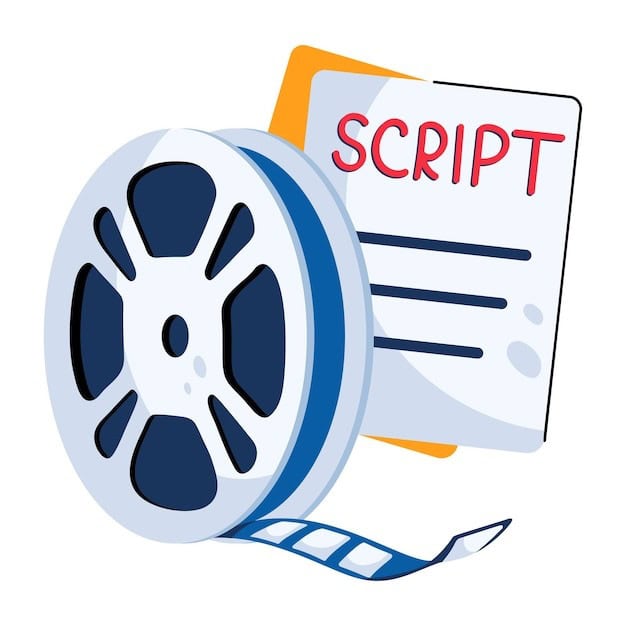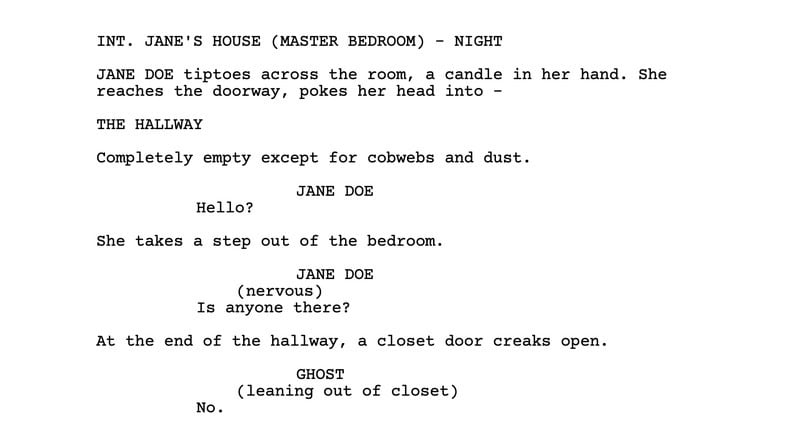Are you a creative with an idea to write a good movie?
Do you think you possess the ability to compose a film worth winning prestigious awards?
If most of your creative ideas lead you to write stories that fall under the thriller, romance, and science-fiction categories, you should transform your idea into a screenplay.
If your favorite movie did not become a screenplay first, how would you have been able to watch it and fall in love?
Writing a screenplay might seem overwhelming.
You might think of it as a skill only the best of Hollywood possess. You can do it too.
As long as you have the passion, idea, and the right guidance, you can turn your idea into the best screenplay that could be produced.
What Is a Screenplay?
You can call a screenplay the blueprint for a movie.
A screenplay is not just a dialogue. It includes descriptions of characters, movements, and transitions.
Screenplays function as guides that direct directors together with actors and production crew members about what will unfold in the film.


Never Worry About AI Detecting Your Texts Again. Undetectable AI Can Help You:
- Make your AI assisted writing appear human-like.
- Bypass all major AI detection tools with just one click.
- Use AI safely and confidently in school and work.
So when you think of a screenplay, think of it as a map or the DNA of a movie.
A screenplay is a way to present your idea in a very specific format that is acceptable and recognized by the film industry.
Difference Between a Screenplay and a Script
As a newbie screenwriter, you might confuse a script for a screenplay.
If you are in this position, just know you are not alone.
It is very common to use screenplay and script interchangeably. But these two terms refer to different things.
A screenplay refers to a document used for film or TV.
It is a guide for all cast and crew members that follows a strict format.
While a script is a broader term that refers to any written work meant to be performed.
It includes any written work for stage plays, radio shows, video games, and even commercials.
A screenplay is well-detailed, while a script is not.
A screenplay details camera angles and scene descriptions while a script doesn’t necessarily include visual details.
Screenplays also follow a standardized format while a script does not have strict formatting.
So when you think of it, all screenplays are scripts, but not all scripts are screenplays.
Step 1: Understanding Screenplay Structure

The structure of screenplays must be well understood by every screenwriter because it forms the basis of their work.
Screenplays can be structured into the following:
The Three-Act Structure
Most standard screenplays follow a three-act structure. They are:
- Act 1 (Setup): This makes up about 25% of your screenplay. The setup is where you introduce your characters and their world. The setup also presents an “inciting incident” that kicks off the story. It is the first 20-30 minutes of your work.
- Act 2 (Confrontation): Act 2 is the middle of your story. It is where you reveal the obstacles that your main character faces. The middle of your story should be interesting enough to keep your audience glued. It is also a good place for character development.
- Act 3 (Resolution): This is the final 25% of your story where everything comes to a climax, leading to the final resolution. The resolution can be happy or sad.
Alternative Structures
Not every story can be expressed through the three-act format.
Although the three-act structure works as a norm, it may sometimes make writers feel confined.
You can choose to tell your story using The Hero’s Journey or non-linear storytelling.
The hero’s journey was polarised by Joseph Campbell and it follows the protagonist’s adventure where he faces trial and becomes transformed.
It is popular among movies such as Star Wars and The Matrix.
The non-linear storytelling tells stories out of sequence.
The writing process using this method may prove difficult at first but proper execution leads to positive results.
You can find this style in films like Pulp Fiction.
Step 2: Coming Up with a Strong Story Idea
Every good screenplay requires a stable story outline. So when trying to come up with a story idea you need to ask yourself a few questions such as:
- What genre am I writing about?
- What is the tone of the movie?
- Who is the main character?
- What is the main character’s goal?
- How do I develop the character?
- How do I create conflict?
- How do I reach a resolution?
A trick to visualize your idea is to write a ‘logline’ – A one-sentence summary of your story.
This summary helps capture the essence of your story and also helps you focus.
Step 3: Developing Your Characters
A big part of your screenplay is the characters.
They are the heart of your play.
So create characters and flesh them out.
They need to feel real and relatable.
If your movie has characters that your audience cannot connect with, then you have a big problem.
A way to easily give your characters life is by asking questions like:
- What is their goal?
- What is their strength?
- What is their flaw?
- How do they speak?
- What is their skin color?
- Where are they from? e.t.c.
Each character needs a clear backstory. Having a backstory for your characters helps you to develop a well-rounded character.
Step 4: Formatting a Screenplay Properly
Even if you are writing for fun, you still need to write in a standard screenplay format.
Using the proper screenplay format is usually where many screenwriters struggle. But you can be different.
Once you understand the proper non-negotiable standard you are good to go!
Here is the proper format of a screenplay:
- Font: Courier
- Font size: 12
- Page Numbering: Upper right corner
- Left Margin: 1.5 inches
- Right Margin: 1 inch
- Top and Bottom Margins: 1 inch each
- Scene Headings: ALL CAPS
- Action Lines: Write in present tense at the left margin of the page
- Character Names: ALL CAPS and must appear before their dialogue. If you are introducing a character you should include a short description in parentheses.
- Dialogue: All dialogues must be centered.
- Locations: Use EXT to indicate “exterior” and INT for “interior”. It should always be before the scene headings.
- Transitions: You should write instructions on scene transitions in ALL CAPS and they should be aligned to the right margin
As a screenwriter, white space should be your friend.
Avoid a crowded paper as they are difficult to read through quickly.
Formatting Example of a Scene in a Screenplay
Here is a standard example of how to write a screenplay format:

Step 5: Writing the First Draft
After understanding the first four steps, it’s time to get to the fun part— actual writing!
The first draft does not have to be perfect. It is okay to make silly mistakes.
Remember that no one has to see this draft but you. Allow your creative mind to work its magic without worrying about perfection.
Here are a few tips to help with your first draft:
- Wait till you finish to start editing
- Set daily writing goals. You can aim for one scene a day. It will add up moving forward
- It is okay to be stuck. Take a break or use a placeholder for a scene and move on.
- Don’t worry about writing in chronological order. You can write the scenes you are most excited about first.
Keeping the Momentum: Avoiding Writer’s Block
You don’t have to beat yourself up. Writer’s block happens to the best screenwriters.
However, there are ways you keep the momentum and avoid writer’s block. They include:
- Jump to a different scene
- Take a walk or a cold shower
- Change your environment
- Listen to music
- Talk to a friend
- Journal
- Read screenplays of other films for inspiration
Alternatively, you can talk to Undetectable AI Chat.
Our chatbot can help you discover a short perspective or explore a different angle or direction.
You can also brainstorm new ideas with the Undetectable AI Chat. Try it out now!

Remember that It is easy to fix a bad screenplay, but not writing at all isn’t.
So instead of giving up, try other options.
Step 6: Editing & Revising Your Screenplay
It’s okay for your first draft to be a little messy. But do not make the mistake of editing immediately after writing.
Once you have your first draft, set it aside for a few days. You need to do your editing with a clear and settled mind.
You will surely find many things to edit if you have a clear head.
Here is how you can edit and revise your screenplay:
- Cut scenes that you feel the film can do without. If it does not add substance, delete it immediately
- Sharpen your dialogues. Movie dialogues are more concise than ordinary conversation. Also, make sure your dialogues are natural and engaging.
- Check the flow of your story. Make sure your story flows well.
- Make sure there is consistency in tone, especially for your characters.
- Ensure that you follow the standard format.
It is totally fine to make so many edits.
Most professional screenplays are edited many times before they are perfect.
You are doing a great job regardless.
Step 7: Selling Your Screenplay & Next Steps
Well done on completing your screenplay. Congratulations on sticking it out!
The next step now is to sell your final draft. You have to make sure your work gets into the right hands.
There are different ways to position your screenplay in the right rooms and they include:
- Create a compelling pitch. Make sure it includes a synopsis and your logline.
- Research production companies that specialise in your genre, For example, Netflix.
- Go to film festivals and conferences to network with the right people.
- Enter reputable screenwriting competitions such as the Nicholl Fellowship or Austin Film Festival.
- Consider producing as an independent filmmaker.
- Get a lawyer to help with negotiations.
- Find a manager or agent to help you sell your screenplay.
When preparing to sell your screenplay, you also have to prepare for rejections.
You wouldn’t be the first screenwriter to be told ‘No’, so it is okay.
Many successful films were rejected before finding the right producer. Be persistent!
Best Screenwriting Software & Tools
Yes, you can write your screenplay using Microsoft Word or Google Docs. But why stop there?
There are specialized tools that can make your work so much easier and faster.
These tools are considered the best according to industry standards and they include:
Final Draft
Final draft is considered the most efficient tool.
It is tagged the “industry standard”. It is used for most professional projects going into production.
It has features such as automatic formatting, scene breakdowns, and character tracking.
The downside is that the final draft software is very expensive.
Celtx
Celtx is not just a screenwriting software. It offers users a “studio” experience.
It also has templates for creating things like a budget, shooting schedule, call sheets, and a shot list.
Celtx is a good option for beginners.
WriterDuet
This screenwriting tool helps writers and editors collaborate online. It was created for the purpose of writing together.
WriterDuet has both free and paid options for users.
Fade In
Fade In simplifies screenwriting. Anyone with basic knowledge of screenplay can use the software without instructions.
The software also allows you to move scenes without having to cut and paste. It is an affordable alternative to Final Draft.
Aside from these tools, you can also use Undetectable AI’s Chatbot and AI Humanizer.
Our chatbot helps with brainstorming ideas for plot, character development, and dialogue.
Our AI humanizer tool can also analyze your dialogue to ensure it sounds natural and realistic.
These tools are like a creative partner you never knew you needed.
FAQs About Writing a Screenplay
How to Write a Screenplay For a Movie?
Have a good idea for a story, follow screenplay formatting, and just write!
How to Write a Montage in a Screenplay?
Label your montage by writing ‘MONTAGE’ in all caps, list scenes briefly and show key moments, focus on action, not dialogue, and conclude by writing END MONTAGE.
How to Write a Screenplay Format?
Use the proper font and font size, take note of margin measurements, use scene headings, know when to write in ALL CAPS, and avoid large blocks of text.
How to Write a Screenplay Format?
Use the proper font and font size, take note of margin measurements, use scene headings, know when to write in ALL CAPS, and avoid large blocks of text.
How to Write a Screenplay Outline?
Break your story into acts, outline key events scene by scene, and develop your characters.
Conclusion
When you decide to write a screenplay, don’t expect a smooth journey. Writing a screenplay is an art.
So to create a beautiful artwork, understand the structure and format of visual storytelling.
Every journey starts with a step and sometimes you need a partner to walk with.
Choose our AI Chat and the AI Humanizer to be your partner on your creative journey and bring your vision to life.
